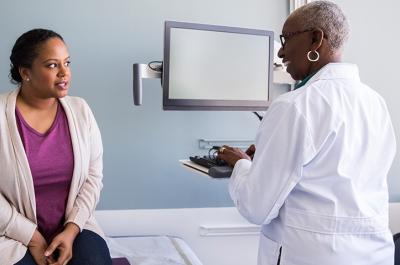Factors That Can Affect Fertility and Ovulation

The test is negative. Again. It’s been quite a few months now since you decided to try to get pregnant. Well-meaning people tell you it takes time. Not to stress. That it’s common. (And it is common — according to the CDC, 10% of women have difficulty getting pregnant, with one-third caused by women’s problems, one-third caused by men’s and one-third caused by a mixture or unknown reasons.1) But still you wonder: Why am I not pregnant yet? Could there be an underlining problem affecting my fertility and ovulation?
The American College of Obstetricians and Gynecologists (ACOG) recommends an infertility evaluation if you’ve been having regular sex without birth control for one year and have not yet gotten pregnant.2 In the meantime, understanding your menstrual cycle and boosting your fertility health can help. If you’re older than 35, that evaluation should happen after six months of trying. If you’re older than 40, you should talk to your ob-gyn before trying to get pregnant.1, 2, 3
Both women and men can experience subfertility or infertility, and in some cases the cause is unknown. While infertility is the inability to conceive after one year of trying, subfertility is defined as unwanted reduced or delayed fertility. Female infertility can be difficult to diagnose and sometimes requires seeing a reproductive endocrinologist.2 According to the ACOG, the most common cause of female infertility is a problem with ovulation.2 If you suspect an ovulation issue, talk to your ob-gyn.
Various health conditions and lifestyle factors can affect ovulation and fertility, and treatment is dependent on a diagnosis. The most common physical or lifestyle factors that can influence fertility include age,3 weight4 and whether or not you consume alcohol or smoke.1, 2, 5
In this article
Health conditions that can affect a woman’s fertility
1. Endometriosis
The ACOG says endometriosis is a sometimes quite painful condition that occurs when the tissue that lines the uterus grows outside the uterus.6 Symptoms include chronic pelvic pain near or during your menstrual period, heavy menstrual bleeding and sometimes pain during bowel movements and/or urination. You may not have any symptoms at all.6 The ACOG says almost four in 10 women experience endometriosis and fertility issues.6 Inflammation caused by endometriosis can damage the egg or sperm, interfere with their movement or cause blockages in the fallopian tubes (which is where the egg and the sperm meet) due to adhesions or scarring.2, 6
2. Hypothyroidism and hyperthyroidism
If you have hypothyroidism with fertility issues, you have an underactive thyroid and your body doesn’t make enough thyroid hormones, possibly causing heavy menstrual bleeding. If you have hyperthyroidism with fertility issues, you have an overactive thyroid and your body makes more thyroid hormone than it needs, possibly causing fewer or lighter menstrual periods than normal. Some studies have linked abnormalities in thyroid function with reduced rates of conception.7
3. Pelvic inflammatory disease (PID)
According to the ACOG, more than 1 million U.S. women are diagnosed with PID each year. Symptoms, which may or may not be present, include pain in the lower abdomen and/or upper right abdomen, abnormal vaginal discharge and/or menstrual bleeding, painful urination and/or sex, nausea and vomiting, and fever and chills. While some cases of PID are caused by non-sexually transmitted infections, most are caused by two STIs — gonorrhea and chlamydia. One in 10 women with PID will become infertile due to fallopian tube scarring.8
4. Polycystic ovarian syndrome (PCOS)
It’s not uncommon for women struggling to get pregnant to find out they have PCOS, a hormonal imbalance that affects the ovaries — and fertility. According to the ACOG, symptoms can include irregular menstrual periods, obesity, excess hair growth, severe acne, changes in skin texture (oily or thick patches of darkened skin) and/or multiple fluid-filled sacs in the ovaries.9 The Office of Women’s Health, U.S. Department of Health & Human Services (OASH) says polycystic ovary syndrome and infertility affects as many as one in 10 women of childbearing age.10 While there’s no cure for PCOS, your ob-gyn can suggest treatments that can help you ovulate, ranging from losing weight or taking medicine to in vitro fertilization (IVF) or surgery.10
Science and technology have made great strides in fertility and offer many solutions. If you’re worried that something is wrong, talk to your ob-gyn. If you need treatment, it may be easier than you realize.

Looking for insights on your health journey? Clearblue® sends you curated, science-backed articles right to your inbox.
Sources:
- Infertility, (n.d.), Office on Women’s Health, U.S. Department of Health & Human Services, retrieved Mar. 19, 2021, from https://www.womenshealth.gov/a-z-topics/infertility.
- Evaluating Infertility, (n.d.), The American College of Obstetricians and Gynecologists, retrieved Mar. 19, 2021, from https://www.acog.org/womens-health/faqs/evaluating-infertility.
- Having a Baby After Age 35: How Aging Affects Fertility and Pregnancy, (n.d.), The American College of Obstetricians and Gynecologists, retrieved Mar. 19, 2021, from https://www.acog.org/womens-health/faqs/having-a-baby-after-age-35-how-aging-affects-fertility-and-pregnancy.
- Weight, fertility, and pregnancy, (n.d.), Office on Women’s Health, U.S. Department of Health & Human Services, retrieved Mar. 19, 2021 from https://www.womenshealth.gov/healthy-weight/weight-fertility-and-pregnancy.
- American Society for Reproductive Medicine. (2018, September). Smoking and infertility: a committee opinion. Fertility and Sterility (110)4, 611-618. https://doi.org/10.1016/j.fertnstert.2018.06.016.
- Endometriosis, (n.d.), The American College of Obstetricians and Gynecologists, retrieved Mar. 19, 2021, from https://www.acog.org/womens-health/faqs/endometriosis.
- Jefferys, A., Vanderpump, M., Yasmin, Ephia. (2015, January). Thyroid dysfunction and reproductive health, The Obstetrician & Gynaecologist, 17(1), 39-45. https://obgyn.onlinelibrary.wiley.com/doi/abs/10.1111/tog.12161.
- Pelvic Inflammatory Disease (PID), (n.d.), The American College of Obstetricians and Gynecologists, retrieved Mar. 19, 2021, from https://www.acog.org/womens-health/faqs/pelvic-inflammatory-disease.
- Polycystic Ovary Syndrome (PCOS), (n.d.), The American College of Obstetricians and Gynecologists, retrieved Mar. 19, 2021, from https://www.acog.org/womens-health/faqs/polycystic-ovary-syndrome-pcos.
- Polycystic ovary syndrome, (n.d.), Office on Women’s Health, U.S. Department of Health & Human Services, retrieved Mar. 19, 2021, from https://www.womenshealth.gov/a-z-topics/polycystic-ovary-syndrome.




